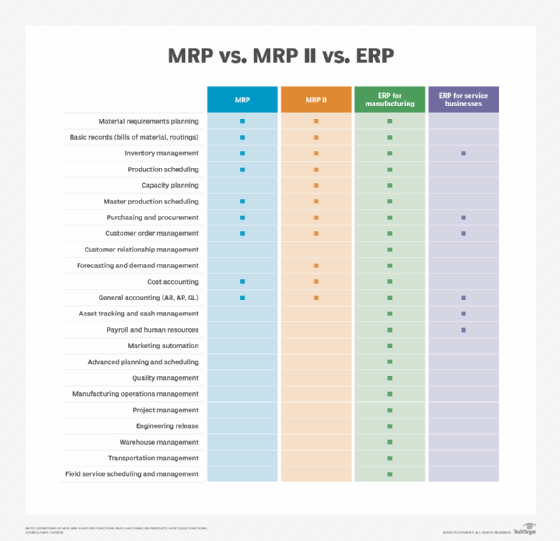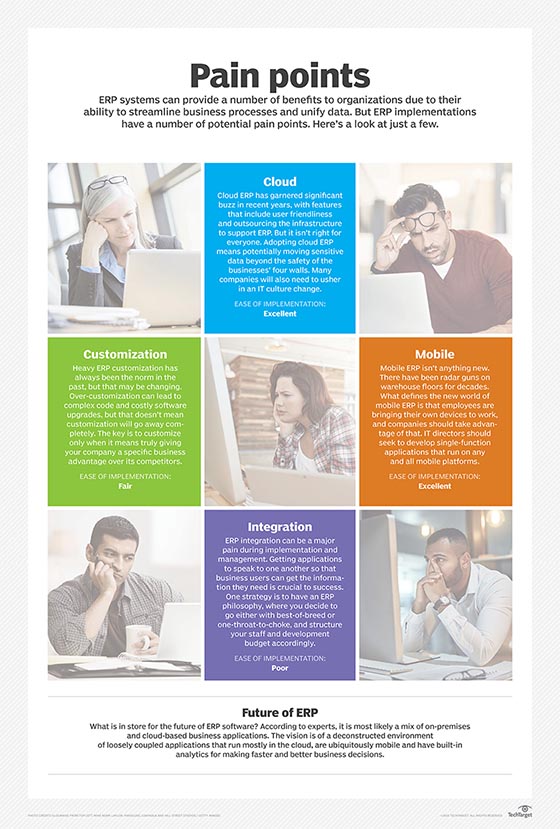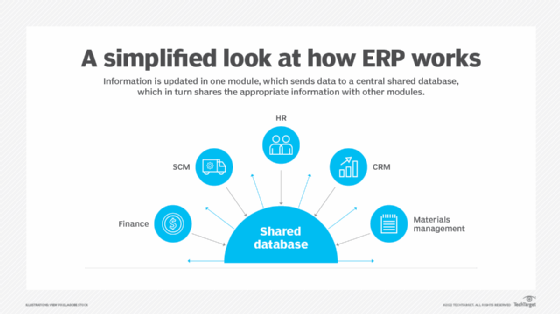What is ERP? Guide to enterprise resource planning software
ERP, or enterprise resource planning, is modular software designed to integrate the main functions of an organization's business processes into a unified system.
An ERP system consists of software components, usually called modules, that each focus on an essential business function, such as finance and accounting, HR, production, materials management and customer relationship management (CRM). Organizations only use the modules they need to run their particular business.
How ERP works
Two characteristics distinguish ERP software from collections of more narrowly focused business software, which vendors and industry analysts often refer to as best-of-breed.
The first is the integration between modules that enables them and their users to interact. For example, a sales order created in the CRM module will be shared with the production module, so the manufacturing department will have the information about what product to make. When the product is shipped, data in the inventory management module changes, and when the customer pays, the accounting module records the revenue.
The other distinguishing feature of ERP software is a central database in which modules record transactions and other information, access that data and share it. Having what the ERP industry calls a "single source of truth" saves users from having to enter information more than once. This in turn improves data accuracy, facilitates reporting and enables collaboration between departments.
History of ERP
ERP's roots start in material requirements planning (MRP), a system for calculating the materials and components needed to manufacture a product that was developed by IBM engineer Joseph Orlicky in 1964. By the 1970s, MRP software was a mainstay of manufacturers.
In 1983, management expert Oliver Wight developed MRP II, which extended MRP to other kinds of resources, including financials, and added support for capacity planning, cost management, shop-floor control and sales and operations planning, among others.
Separately, consultants and vendors in the 1970s began to develop networked mainframe software for managing financial processes, including accounting and payroll, on a single database. Two of these startups, Baan and SAP, grew rapidly to become leading vendors of software that by the early 1990s became widely known as ERP.
Analysts at research firm Gartner concluded that a new term was needed for the growing category of modular, integrated business software that went beyond manufacturing processes to encompass back-office functions, such as HR and accounting. In 1990, it coined the term enterprise resource planning to denote this more general-purpose software. MRP didn't go away, and the still-distinct purposes of MRP vs. ERP ensure a continuing role for both. Today, most ERP suites sold to manufacturers have an MRP module. The term MRP II, on the other hand, has become synonymous with ERP and is rarely used.
In three decades of existence, ERP has undergone seismic shifts in its technical underpinnings that have fueled exponential growth. ERP is today the must-have software for all but the tiniest businesses.
In the early days of ERP-like business software in the 1970s, the software ran on mainframe computers on premises in the owner's data centers. By the 1990s, mainframe ERP vendors began migrating the software to the client-server model, where desktop devices communicate with a central server. ERP was now accessible to more users more affordably. User friendliness improved from the clunky character-based UIs of mainframe days as ERP vendors added Microsoft Windows-like GUIs to client software and, soon, Windows itself. By the mid-1990s, as the web grew in popularity, client-server ERP products were being retrofitted with web browser-like UIs-- even if the systems themselves remained resolutely locked inside corporate networks.
The arrival of cloud ERP in the late 1990s was the next fundamental shift in how ERP was delivered and consumed. Cloud computing made it feasible for companies to connect their ERP systems to customers, suppliers and partners. It also made web browsers the standard UI for most new ERP systems.
The service-oriented architecture of the cloud -- with its loose coupling of clearly defined units of software, each with is own distinct purpose -- enabled a mix-and-match approach to ERP modules. The result was what Gartner calls "postmodern" ERP, in which the old model of a single monolithic ERP system from one vendor is, in theory, replaced with a patchwork of integrated applications from different vendors.

Key features of ERP systems
Four ERP concepts differentiate the software from most other types of business applications:
- comprehensive integrated business processes
- modularity
- central database
- consistent look and feel across applications
Most ERP systems handle certain essential, or core, business processes -- either in dedicated modules or in sub-functions of other modules -- that are common to all kinds of businesses. The ERP finance module is the only one that is in every ERP product, since every company needs the ability to process financial transactions and account for them. It automates basic accounting, invoicing, financial analytics, forecasting and reporting.
Other commonly used core ERP modules are as follows:
- human capital management (HCM)
- order management
- sales management or CRM
- purchasing or procurement
Companies that make or distribute products need additional modules with specialized capabilities. The most common ones include the following:
- MRP;
- inventory management;
- manufacturing management, or production management; and
- supply chain management (SCM): complex processes for demand planning and logistics, including transportation management systems and warehouse management systems.
Some organizations add still another layer of modules that are even more specialized or provide advanced capabilities that go beyond what's possible with the standard modules. For example, a company might augment the basic HR functions -- such as payroll, benefits and employee records -- of its HCM system to add talent management software with modules dedicated to recruiting, training, evaluating and compensating employees. A consultancy, construction firm or other organization whose work is typically organized into projects might add a project management module. A manufacturer with its own distribution centers might buy an SCM suite from another vendor that has sophisticated transportation and warehouse management software that comes with prepackaged integration to the ERP.
In recent years, ERP vendors have bolstered their products with emerging technologies that are sweeping through other sectors of the IT industry. Today, the hottest ERP trends are all about making ERP more interactive, intuitive and "intelligent."
Chatbots are taking over many of the ERP tasks, such as invoice processing and customer service, formerly handled by humans. AI improves ERP data analytics by "learning" to recognize patterns and make recommendations. Natural language processing makes it possible to control ERP by speaking into a voice user interface.
Benefits of ERP systems
ERP offers numerous benefits, most of which come from information sharing and standardization. Because ERP modules share data more easily than disparate or unconnected systems, they can make cross-departmental business processes easier to manage. They can also enable better insights from the data generated in daily transactions or coming into ERP systems from newer technologies, such as IoT.
In addition, ERP software does the following:
- boosts efficiencies by automating data collection;
- enables growth by managing increasingly complex business processes;
- helps lower risk by enabling better regulatory compliance;
- fosters collaboration through improved data sharing and communication; and
- improves supply chain management.
Businesses typically turn to an ERP system when they outgrow spreadsheets and siloed applications and need the unifying capabilities of an ERP system to enable growth.
Advantages and disadvantages
The sheer size, interconnectedness and complexity of ERP is both a blessing and a curse.
When it is running well and is closely aligned with an organization's ways of doing business, ERP makes things run more smoothly and opens up new possibilities. But when deployment is delayed or the system goes down unexpectedly, ERP can bring business to a standstill and force users to scramble, looking for manual alternatives. And an older ERP system with unintuitive screens and poorly designed workflows can put a drag on a business that threatens its very existence.
But the biggest disadvantage of ERP, one that has frequently led to lawsuits, is the significant risk and cost of a failed or severely delayed implementation. ERP implementation failures often make headlines. At least two such failures involved projects that topped $1 billion. One high-profile case was the 2018 suit that investors of cosmetics maker Revlon filed when problems implementing SAP ERP allegedly disrupted manufacturing operations and delayed shipments.
Nevertheless, the advantages of ERP usually outweigh the disadvantages. Among the highlights are the following:
Advantages
- ERP can save businesses money over the long run by streamlining processes.
- It provides a unified system that can lower IT, labor and training costs.
- It enables greater visibility into critical parts of the business, such as sales, working capital and inventory.
- It facilitates reporting and planning through improved data and analytics.
- If offers better compliance and security through fine-grained control of user rights and standardized workflows.
Disadvantages
- ERP software can be expensive to deploy and maintain.
- It is often difficult to implement.
- It requires significant change management.
- ERP modules are often less sophisticated than specialized software and go unused or must be replaced.

ERP implementation
ERP implementation best practices call for a formal process, overseen by an ad hoc team drawn from every major department, that extends from the conceptual stage to post-implementation support and, ultimately, upgrading or replacing the system. Project management methodologies, tools and software are essential in managing what could be a multiyear process.
It starts with understanding the organization's current and aspirational ERP use cases, then gathering the requirements and wish lists of stakeholders. This requirements-planning stage provides the framework for researching ERP software vendors to generate a shortlist of products most likely to meet the requirements.
Next, vendors are called in to demonstrate how their software performs in real-world circumstances, sometimes in a competitive "bake-off."
The ERP selection team might then run a limited pilot before signing a contract with the vendor.
In the case of an ERP upgrade from one system to another, companies usually run and test the new ERP system in parallel with the old one to ensure that it works properly before committing to a launch date. Data migration then consumes much of the time and resources needed to ensure the new system can take over business processes with minimal disruption.
The best practices don't end when the system is deployed. Companies must communicate the benefits and features of the new system in advance, then maintain a training process for current and incoming employees. A comprehensive, effective change management strategy can be the difference between ERP implementation success and failure.
Multi-tiered ERP systems
Tier has two meanings in the context of ERP.
The most important -- because it describes an actual software architecture -- is what's referred to as two-tier ERP, a strategy that typically involves pairing a large, often on-premises legacy ERP system in corporate headquarters with smaller, cheaper, often SaaS-based ERP systems at divisions and remote offices. The two tiers are integrated, especially for accounting, finance and other companywide processes, such as HCM, and can be from different vendors.
Two-tier ERP can be a good strategy for extending ERP to more locations while providing remote offices with more control, flexibility and agility to meet local needs.
The second use of tier is as a way of classifying ERP software and vendors by size. In this scheme, tier 1 ERP products are built for and typically purchased by the world's largest name brand companies and sold by the biggest vendors. The tier 1 group usually includes SAP, Oracle, Microsoft and Infor. Tier 2 vendors are next in the rankings, measured roughly by revenue. Like tier 1 vendors, they sell systems for both large companies and SMBs. Tier 3 vendors are the smallest and often sell ERP for niche industries.
The tier-ranking system for vendors and products is highly arbitrary, is subject to disagreement and has begun to fall out of use.

ERP vendors
SAP topped the list of vendors in Gartner's 2018 global ERP market report, with 22% market share, followed by Oracle (11%), Workday (7%), Sage Intacct (6%), Infor (5%) and Microsoft (4%). With the exception of SaaS-native Workday, the market leaders all began with on-premises ERP but now sell a variety of ERP brands for both cloud and on-premises deployment.
Other prominent mixed-platform vendors include Epicor Software, IFS, QAD and SYSPRO. SaaS-only vendors include Acumatica, Kenandy, NetSuite and Plex Systems.
ERP support
ERP vendors or their support partners offer tech-support services, usually contracted for an additional fee. They typically include a helpdesk reachable by phone, email or online; a dedicated customer web portal with FAQs, user manuals and other documentation; and access to discussion forums. On-site support typically provides implementation assistance, troubleshooting and training. Software development may be a significant part of support if the ERP system needs customizing, extending or integrating with other systems.
Most companies maintain their own ERP support staff even if it is just one IT person who has other responsibilities. Larger companies may have several people whose job it is to keep the ERP system running, train users and interact with the ERP vendor, systems integrator or service provider. ERP administrator is a common title in the IT world.
The growing popularity of cloud ERP is bringing major changes to the internal ERP support function, which used to focus mostly on maintaining the ERP system itself. Now, ERP administrators must be knowledgeable about the capabilities of SaaS business applications, figure out how to assemble them into an ERP system, and understand the needs of customers and other external users.
On-premises ERP vs. cloud ERP vs. hybrid ERP
In most cases, cloud ERP doesn't require the IT infrastructure of on-premises ERP. A cloud ERP implementation can therefore be far cheaper in terms of purchase, deployment and maintenance costs.
Thanks to the elasticity of cloud computing resources, cloud ERP can also be easier to scale up and down as needs fluctuate, and automatic upgrades deliver new technologies faster, typically without hassle.
However, not all cloud ERP deployment options are alike, and ERP vendors often fudge the terminology. Private cloud and hosted ERP typically just involve running the same on-premises software on an outside provider's data centers, though they may have some real characteristics of cloud computing, such as economies of scale from shared infrastructure as well as on-demand use and pricing. Some companies maintain their own private cloud infrastructure.
Early cloud versions of ERP had fewer modules and capabilities than on-premises versions, though in recent years the two have neared parity. One type of cloud ERP, multi-tenant SaaS ERP, is usually streamlined with fewer modules and features. Multiple users share the same copy of the software, which makes it cheaper, simpler and more standardized than most on-premises ERP.
Unlike on-premises ERP, which usually requires an expensive, long-term license paid up front, SaaS is generally sold by monthly, per-user subscriptions. However, the differences between cloud ERP and on-premises ERP aren't quite so clear cut because some vendors combine features of the two.
SaaS ERP usually can't be customized, which is a major drawback for companies that need the custom features and integrations of an on-premises ERP system into which they have usually sunk significant time and money. As a result, hybrid ERP, which combines on-premises and cloud ERP modules and related applications, is an increasingly popular way to gain some of the technological benefits of SaaS without losing the security of a familiar legacy system. It raises daunting integration challenges, however.
The challenges of finding the right balance between on-premises, cloud and hybrid ERP and combining applications that work well together will define practically every ERP implementation of the 2020s.
Importance of ERP
Few observers would doubt that ERP has had a positive influence on the global economy. The anecdotal evidence from individual companies is both convincing and unsurprising, and it springs largely from the usual benefits of computerizing manual, paper-based processes.
Digitizing business transactions and records usually speeds them up and makes them more accurate and reliable. Sharing this real-time or near-real-time information over a network helps workers across departments make better decisions, coordinate their activities, collaborate more effectively and minimize the avoidable errors caused by miscommunication. It also helps businesses respond more quickly to changing conditions.
Tapping into the internet to open these ERP channels to the outside world helps to align supply and demand by tying the desires of customers more intimately to the actions a company, its suppliers and partners take to develop and deliver products and services.
This ongoing "digital transformation" of nearly every corner of the business world, enabled in large part by ERP, has made new conveniences, such as mobile e-commerce, possible. It has also helped to integrate the world economy by enabling, or at the very least supporting, global manufacturing, supply chain analytics and industrial IoT. At the same time, digital transformation calls for a new set of ERP skills that emphasizes broad business expertise and collaboration.
Meanwhile, demand for ERP continues the steady growth that began in the days of green screens and client-server architecture. Most research firms report ERP revenue roughly doubling in the past decade. In 2018, it reached $35 billion, according to Gartner.






